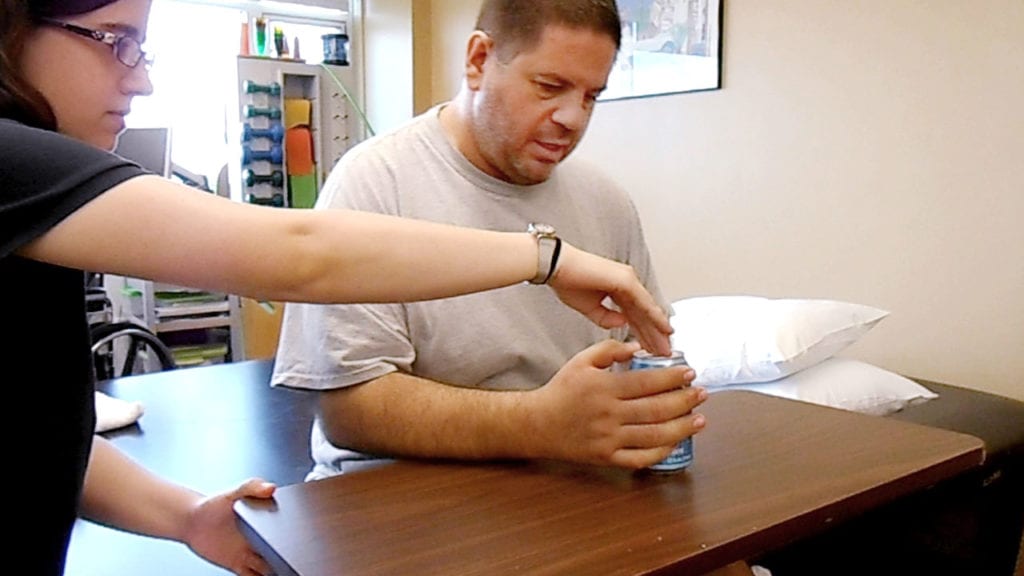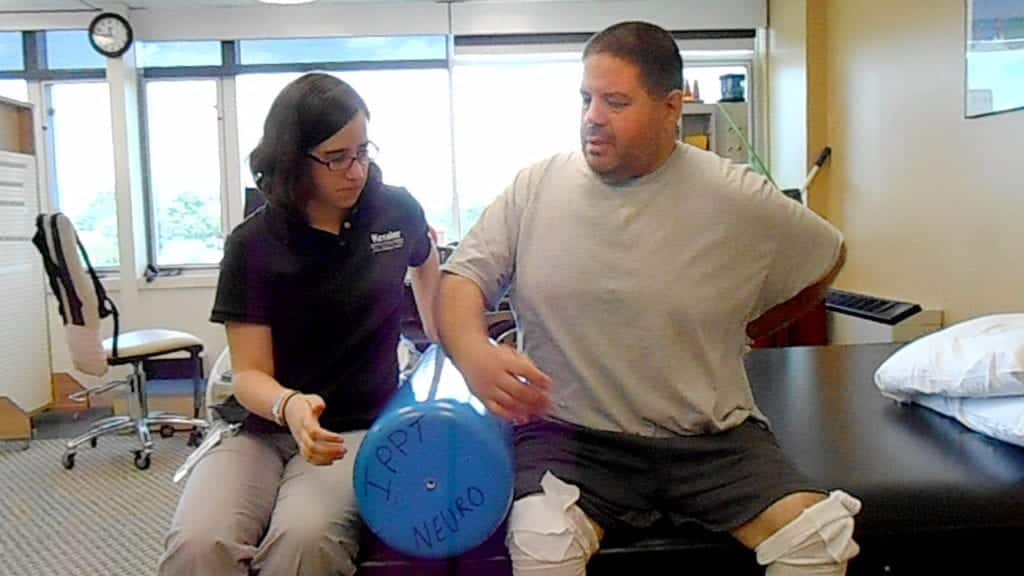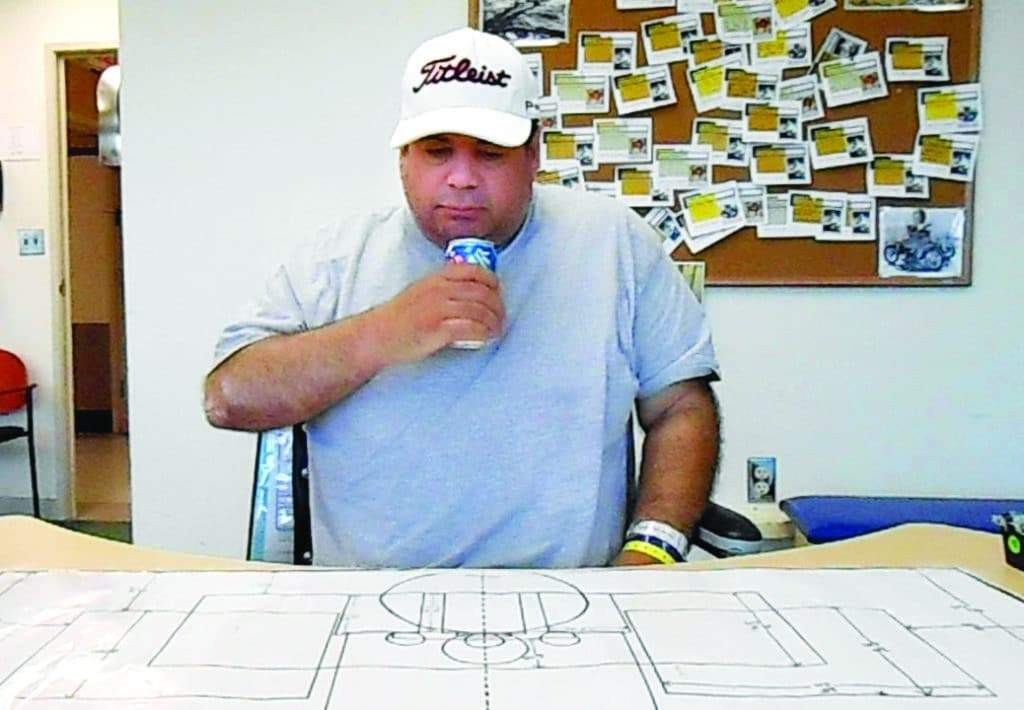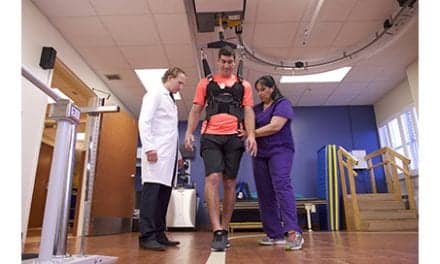by Gretchen E. March, OTR, and Katherine Groendyk, MOT, OTR/L
Putting evidence-based research into practice can be a complex and rewarding experience. This article hopes to outline our journey and provide information for those looking to operationalize and promote evidence-based programs (EBP) in their own sites. Kessler Institute for Rehabilitation’s stroke team in New Jersey worked to do just that. What follows are the challenges, steps taken, and the eventual successes of this process.
Why don’t we get excited to present new information?
Therapists often strive to include evidence-based concepts into their treatment. When working with large groups, it is difficult to achieve “buy-in” for new ideas. We like what we know. Literature shows that reasons for not adopting new research into practice varies and includes the following: lack of confidence in our own knowledge, fear of appearing uncertain in front of others (peers, families, and patients), and difficulty explaining rationales. This is evident in the clinical setting.
Clinicians’ values and attitudes regarding EBP affects implementation. We asked ourselves, what are your attitudes toward new programs and concepts? How often are you appraising your practice and outcomes? What is your attitude toward change? The answers can help drive a successful process.
Building meaningful change
Using concepts borrowed from Implementation Outcomes Research was key in facilitating clinical change. The OT stroke team members researched and decided to implement a Constraint Induced Movement Therapy (CIMT) approach to upper extremity (UE) motor control with stroke patients on our service.1 When looking at why our teams did not readily embrace CIMT, several frequent themes appeared. Time constraints, lack of familiarity with the literature, fear of feeling incompetent in front of patients, staff and families, and the “too many other things to do” category. This greatly helped tailor our education efforts to alleviate these attitudes.
We held several educational in-services about the CIMT approach and adopted the use of Wolf Motor Function Test (WMFT) pre-treatment and post-treatment. As therapists started to see the results, the buy-in for the program and the process improved dramatically. Holding people accountable to using the outcome tools required mentoring and auditing to ensure compliance. Senior staff members were excited to assist in this process as it was a good demonstration of expertise and assisted them in moving up the clinical ladder.
Changing Clinical Behavior
The process of changing clinical behavior utilized the following implementation outcome principles as a way of facilitating therapist acceptance and compliance. First, we looked at acceptability. Did we think this EBP of CIMT is agreeable with our practice? We agreed this program would benefit a wide variety of stroke patients. Next we considered, did we perceive the fit/relevance to our practice, ourselves, and our patients? The answer was yes. Creating and having access to outcomes (the WMFT) for our patients and their families would greatly enhance our ability to make meaningful change in the motor control of our stroke population.
Lastly, it was important that the fidelity of the research be maintained as closely as possible. Was the intervention implemented as it was prescribed in the original protocol or as it was intended by the program developers? Fidelity is necessary to produce expected outcomes. Could we ensure the fidelity of this EBP concept? We determined that with education the fidelity of the CIMT concepts could be maintained. We then turned to feasibility and adoption of the program. We determined that the program was feasible and the operationalization would assist in better, more goal-directed use of 45-minute treatment sessions.2
Education
A train-the-trainer approach was adopted to ensure success. Intensive mentoring with “Clinical Champions” was completed, and training was conducted for the inpatient (IP) and outpatient (OP) staff. The basic concepts of CIMT were reviewed, role play, and analysis of past patient data were used to help staff gain confidence in their use of data generated from their assessments to drive treatment plans. Follow-up meetings to discuss challenges and successes were also conducted. Clinical champions from multiple campuses in our hospital worked together to share and disseminate information as it was showing success. Web-based meetings were held initially to answer questions and to efficiently share experiences and report where we were in the process of implementation.
CIMT Approach
CIMT is an approach used for improving UE motor control following stroke. It was developed by Edward Taub et al and first reported on use in stroke population in 1993. The efficacy was demonstrated by a multi-site randomized controlled trial EXCITE 2006.3 There are now more than 300 CIMT therapy studies reporting positive outcomes using CIMT approaches. The basic concept of CIMT is how the cycle of learned nonuse can impact recovery of motor control negatively after stroke. CIMT uses restraint of the sound arm to drive use in the affected arm, effectively “constraining” learned non-use.
Using a standardized assessment, both pre and post treatment allowed our team to see the results and to compare to the evidence-based research. The assessment used was the WMFT, the assessment used in the Taub clinic and in the EXCITE trial. Next, the concept of shaping, making progressively improved movements with the affected arm is vital to the approach and is often misunderstood by therapists. Education was conducted to increase understanding and mastery for this concept. Pairing staff with mentors during initial phases was integral in developing staff competencies. The materials used were from the Taub clinic at UAB. Task practice was added following shaping trials to promote use of the affected extremity in real-life tasks to promote use.4
The final component of the CIMT program is the transfer package. The transfer package consists of a behavioral contract, daily home diary, a Motor Activity Log (MAL), problem-solving aspects of the MAL with therapist before performing at home, and home skills assignments (5 easy and 5 hard). This can be difficult to perform and monitor in an IP setting but has shown to improve the magnitude of the results at the Taub clinic and is reviewed for use at home.
The patients in IP rehab are, at times, at a lower level and cannot yet perform the tasks in the MAL. Our team has modified some tasks for this population to start using in their rooms during their stay transitioning to MAL and home skills assignments as they progress. The need for a continuum of care was evident so our outpatient treatment team is involved and able to carry out and progress patients referred from IP to OP setting. The approach requires that the patients served be actively involved in all aspects of this approach not only while in therapy sessions but also at home. This holds patients accountable for their own improvement. The effect of the CIMT treatment with the transfer package shows an improvement 2.4 times greater than the CIMT without the transfer package.5
Technology
The use of technology with CIMT has been useful in our clinical settings. The stroke teams are undertaking the next phase of design to determine which technologies to use and when. The technology can be especially useful when patients have very little initial movement patterns. Fully robotic devices, NMES therapy as well as use of exoskeleton technology are all options for the remediation of UE motor control in the stroke program at our hospitals. The use of technology is an adjunct to the CIMT program, targeting developing movement patterns and engaging our patients in ways that facilitate high numbers of repetition and result in massed practice.6
Fully robotic training and NMES is especially useful for patients with no active movement; it can provide the impetus for movement if followed by trials of shaping to coach the developing patterns. Exoskeleton training is used for patients with a little bit of motor control. Technology used prior to shaping can “prime” the patient for the upcoming shaping tasks. There has been a positive response to the technology. However, care must be taken to continue to keep the patient actively involved in the process to drive the neuroplasticity.7
Success Stories
Since implementation of a CIMT approach at Kessler, the success stories have been inspirational. One gentleman came to IP rehab after a significant left MCA stroke resulting in profound right hemiparesis. He had just trace movement in his right shoulder elevation and retraction. He was an avid guitar player. During his stay of 21 days, he participated in shaping, task practice, and robotic technology. Initially he could not bring his arm to the table, had no effective grasp or release, and could only bend his elbow slightly.


After working extremely hard and completing his homework every night, he showed significant improvements. He was able to bring his arm to the table, and grasp and lift a can toward his mouth. He worked hard and went from 0-25# of gross grasp in a week. Then 4 days later he gained an additional 10# to achieve 35# grasp in 11 days!

He was so pleased with his progress and went on to OP therapy at discharge. When leaving IP rehab he bought and donated a guitar to the CIMT lab so patients would have something with which to practice shaping.
Another year passed, and he was asked to speak at our Annual Stroke Conference. As he arrived, he waved both hands above his head and it was difficult to see which arm had been so hemiparetic initially. He had resumed playing guitar, writing, and drawing with his affected arm—a testament to being actively engaged and following through with his protocol.
It is worthwhile to implement evidence-based research protocols into your clinical practice. It requires significant effort to review literature and design your process using the protocols from the research. Maintaining fidelity is an important component of program development as you need to design the program as close as possible to the research if you expect to achieve similar results. When you complete pre and post WMFT tests and see the positive results, it is rewarding to know that you have helped your patients take control of their program; now they are “thinking like therapists.” In our CIMT lab we tell patients to think like athletes, set goals and keep focused using drills (shaping), and practice, practice, practice. RM
Gretchen E. March, OTR, is an Advanced Clinical Specialist OT at Kessler Institute for Rehabilitation, a division of Select Medical Corp, Saddle Brook Campus, Saddle Brook, NJ.
Katherine Groendyk, MOT, OTR/L, is a Clinical Specialist Occupational Therapist at Kessler Institute for Rehabilitation, a division of Select Medical Corp, Chester Campus, Chester, NJ. For more information, contact [email protected].
References
- Taub E, Miller NE, Novack TA, et al. Technique to improve chronic motor deficit after stroke. Arch Phys Med Rehabil. 1993;74(4):347-54.
- Proctor E, Silmere H, Raghavan R, et al. Outcomes for implementation research: conceptual distinctions, measurement challenges, and research agenda. Adm Policy Ment Health. 2011;38(2):65-76.
- Wolf SL, Winstein CJ, Miller JP, et al. Effect of constraint-induced movement therapy on upper extremity function 3 to 9 months after stroke: the EXCITE randomized clinical trial. JAMA. 2006;296(17):2095-104.
- Hubbard IJ, Parsons MW, Neilson C, Carey LM. Task-specific training: evidence for and translation to clinical practice. Occup Ther Int. 2009;16(3-4):175-189.
- Taub E, Uswatte G, Mark VW, et al. Method for enhancing real world use of a more affected arm in chronic stroke. Stroke. 2013;44(5):1383-1388.
- Bartolo M, De Nunzio AM, Sebastiano F, et al. Arm weight support training improves functional motor outcome and movement smoothness after stroke. Funct Neurol. 2014;29(1):15-21.
- Duret C, Grosmaire AG, Krebs HI. Robot-assisted therapy in upper extremity hemiparesis: overview of an evidence-based approach. Front Neurol. 2019;10:412.





